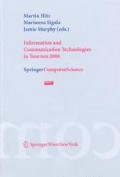Abstract
The field of mobile computing is evolving fast. More and more people start using Personal Digital Assistants (PDA). However, nowadays, many tourists plan their vacation based on web sites, magazine articles and guidebooks. These tourists visit a region or city during one or more days. During such a limited period, tourists need to select what they believe to be the most valuable attractions. After selecting their destinations, tourists try to make up a practical plan to visit them. They should think about an estimated duration of each visit, the good and bad moments to visit each attraction, and a good visiting sequence. Unfortunately, sudden changes in weather condition or a longer stay in one of the attractions may disturb the planning during the trip. As soon as the current plan becomes infeasible, they have to start all over again to find an attractive plan for the remaining part of their trip. Some guidebooks acknowledge these problems and propose standard visitor tours through a city or region. Obviously these tours are all constructed to satisfy the interests of the majority rather than the specific interests of individuals. Electronic Tourist Guides (ETGs), handheld embedded devices, can be a great help for tourists who want real support for these types of problems. Current, state-of-the-art ETGs help tourists in choosing their destinations and then they provide shortest routes between these destinations. However, algorithms for integrated selection and routing arc not available yet. In this article, suggestions are made for designing an integrated planning tool based on information about the user, the attractions and the trip. Furthermore, this article describes different opportunities for ETGs of the next generation. ETGs will be equipped with new possibilities that allow more personal, flexible and user-friendly tourist guidance. The technology called for is already available, algorithms and software can be developed soon. It is crucial that such a system keeps providing reliable, up-to-date information on all tourist attractions and activities. Further research is needed to assess the exact impact of new generation ETGs on contemporary tourism. That this impact will be substantial is beyond dispute. When used as a servant, not as a master, the ETG of the future can assist tourists in being much better informed, in exploiting their holidays as fully as possible, in enjoying more thoroughly the things they really want. Our thesis is the practical feasibility of designing a Next Generation ETG.
Author information
Authors and Affiliations
Editor information
Editors and Affiliations
Rights and permissions
Copyright information
© 2006 Springer-Verlag Wien
About this paper
Cite this paper
Vansteenwegen, P., Van Oudheusden, D. (2006). Selection of tourist attractions and routing using personalised electronic guides. In: Hitz, M., Sigala, M., Murphy, J. (eds) Information and Communication Technologies in Tourism 2006. Springer, Vienna. https://doi.org/10.1007/3-211-32710-X_8
Download citation
DOI: https://doi.org/10.1007/3-211-32710-X_8
Publisher Name: Springer, Vienna
Print ISBN: 978-3-211-30987-2
Online ISBN: 978-3-211-32710-4

